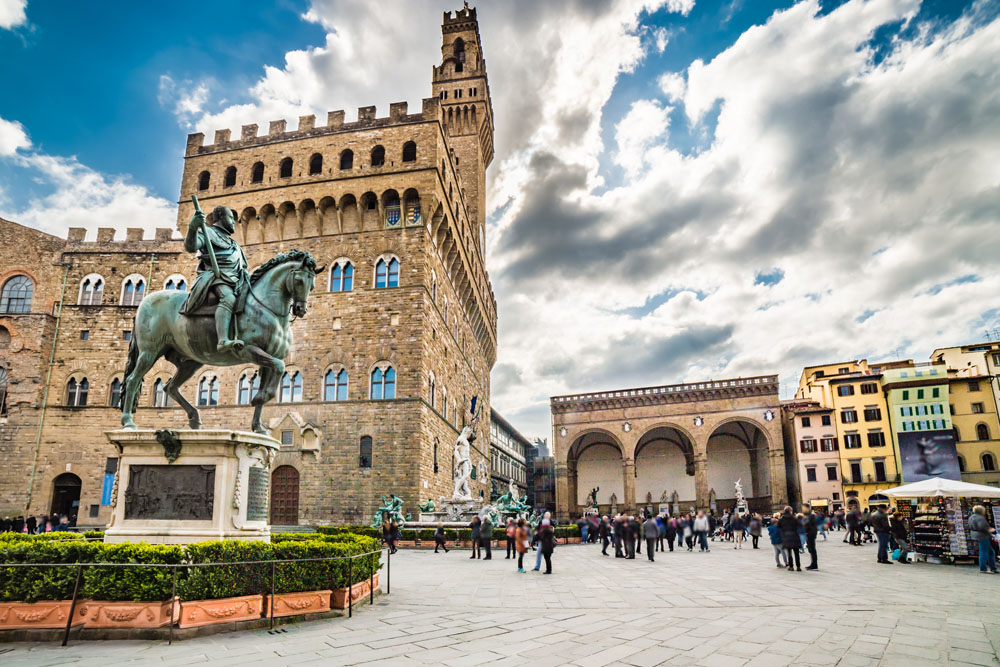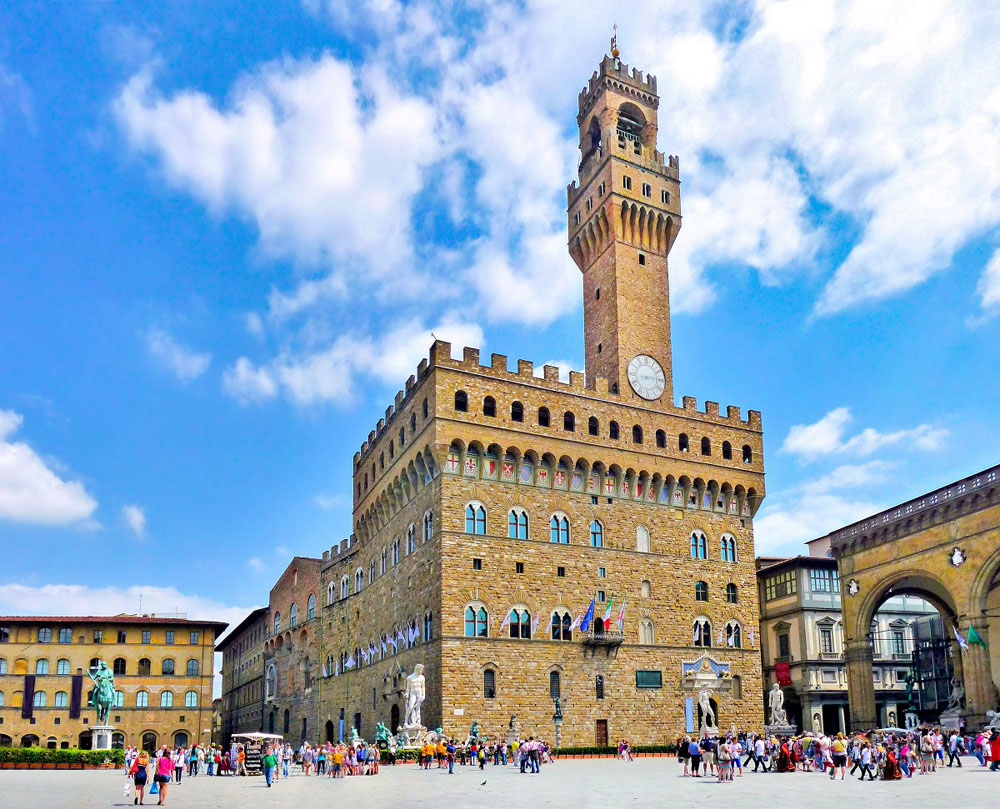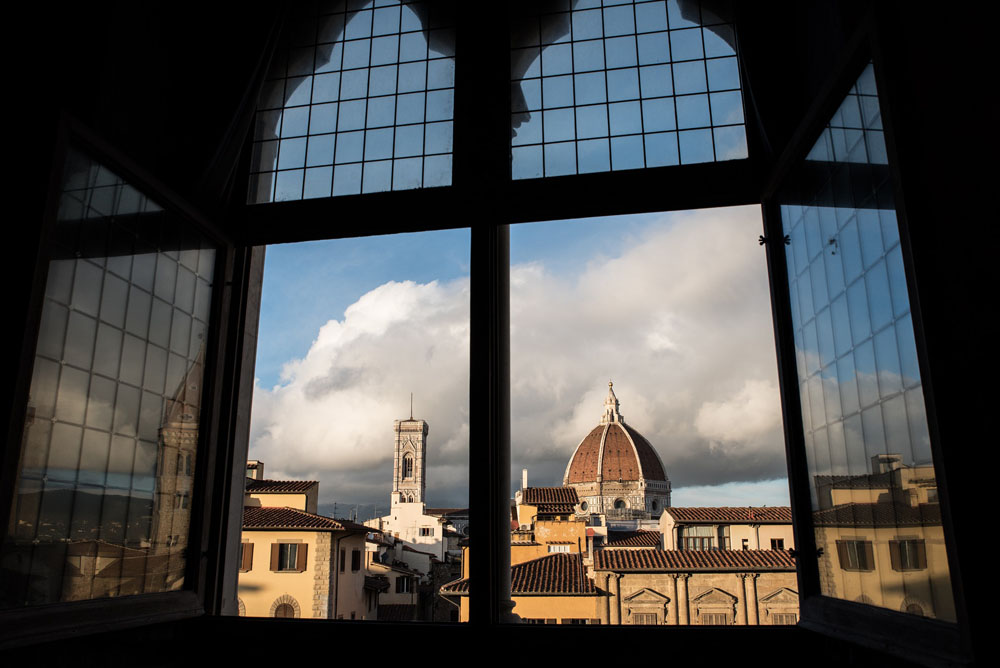Palazzo Vecchio guided tour in Florence





The heart of Florence's history and politics for over 800 years
Palazzo Vecchio or Palazzo della Signoria is an imposing palace-fortress overlooking the splendid Piazza della Signoria and was the seat of the city’s local government for over seven centuries and one of the most famous symbols of Florence! Even today it is the prestigious seat of the Municipality of Florence, here the Mayor of Florence has his office and the City Council meets to make decisions for the city.
When it was the Palazzo della Signoria
Built in the early 1300s, the palace was originally known as Palazzo della Signoria, since “Signoria” was the name of the city government before the rule of the Medici: a city-republic, where the citizens had Rome as a model, a voting population of elites and elected officials. The Florentines decided to create a system of government that would never allow anyone to gain enough power to take over, and so they conceived the Signoria, or council of elected rulers, which began in 1282. While in office, rulers were kept within of the building and never allowed to leave, because outside they could be kidnapped and contaminated by the various lobbies. The Signoria’s apartments, decorated with painted wooden ceilings, were and still are on the top floor (Prior’s Apartments). The ground floor was originally open, a place where people could gather, talk and trade. It was later closed so that a garrison could defend the palace from attacks. At the lower levels, the representatives of the people received the laws sent by the Lordship and could vote to accept or reject them.
Here you can admire Michelozzo’s Courtyard, the splendid entrance area to the palace, entirely frescoed in 1565 with refined grotesque motifs and views of cities of the Habsburg Empire in homage to the arrival in Florence in the ducal residence of Joan of Austria married to Duke Francesco I de’ Medici.
And when under the Medici it became the “Palazzo Vecchio”
After being opposed and driven out of Florence at the end of the 15th century, the Medici increased their power and prestige by having two popes elected from the family. Under the protection of the Spanish they marched, got rid of the Signoria and in 1531 finally had themselves crowned dukes. They moved into the Palace, literally occupying the seat of the Signoria and this marked the definitive end of the Republic. The old palace needed to be renovated, and it was Vasari’s task to transform this icon of the much-loved Republic into a symbol of the new glorious Medici monarchy. They moved into the Palace, literally occupying the seat of the Signoria and this marked the definitive end of the Republic.
The wonders inside Palazzo Vecchio
Once it passed to the Medici, Dukes of Florence and then Grand Dukes of Tuscany, the old palace needed to be rebuilt, and it was Vasari’s task to transform this icon of the much-loved Republic into a symbol of the new glorious Medici monarchy. The palace was redecorated by Vasari and his assistants with new frescoes and ceilings depicting the military victories of the Medici in Tuscany (Salone dei Cinquecento), the stories of the most famous members of the family (Apartments with stories from the life of Pope Leo Vecchio, Lorenzo the Magnificent on the first floor), other stories of Greek and Roman Gods and Goddesses and Allegories of the Four Elements (Apartments on the second floor). For the private use of Cosimo I’s eldest son, the future Duke Francesco I, the exquisite environment of Francesco I’s Studiolo was decorated with sophisticated paintings by Florentine mannerist artists. Bronzino, who was the favorite painter of Eleonora di Toledo, Cosimo’s wife I, decorated Duchess Eleonora’s private chapel with splendid mannerist frescoes, while the ceilings of the other rooms of her apartment were decorated with stories of classical heroines celebrated for “equaling the virtues of men”, by Vasari’s assistants. The magnificent Hall of Geographical Maps which concludes the visit is a magnificent environment with cabinets specially made in the 16th century to contain maps from all over the world and represents an extraordinary document of the cartographic knowledge of the world in the mid-16th century.
Palazzo Vecchio is one of the best places in Florence to visit with children and teenagers.
This is why we at Artours organize special tours of Palazzo Vecchio for children and families!
Dettagli del Tour
- TYPE OF TOUR: PRIVATE FOR INDIVIDUALS OR GROUPS – BY RESERVATION
- AVAILABLE ON DAYS: Monday, Tuesday, Wednesday, Friday, Saturday, Sunday 9 AM-4 PM Thursday 9 AM-12AM
- DURATION: 3 HOURS
- TYPE OF SERVICE: GUIDED TOUR
- DIFFICULTY: Easy, suitable for children aged 6 and over and teenagers
- MEETING POINT: Piazza della Signoria, in front of the Palazzo della Signoria next to the copy of Michelangelo's David
- NOTE: OPTIONAL BOOKING AND PRE-SALE PURCHASE OF TICKETS €17 per person
- EARPHONES €2.00 per person
What you will see on the Tour of Palazzo Vecchio in Florence
- Piazza della Signoria with its extraordinary statues with political messages
- Michelozzo’s Courtyard
- The Salone dei Cinquecento
- The Study of Francesco I
- The Neighborhood of the Foreign Princes
- The Neighborhood of the Elements
- The Chapel of Duchess Eleonora of Toledo
- The apartments of Duchess Eleonora of Toledo
- The Chapel of the Priors
- The Halls of the Priors
- The Hall of Geographical Maps



